Nightingale's Vancouver Aquarium - The Real Thing
Sunday, February 07, 2010
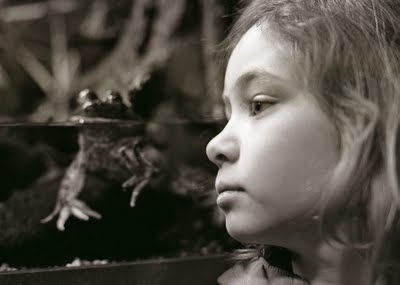 In 1975 when we arrived to Vancouver from Mexico one of the most ubiquitous bumper sticker and car rear window adornments featured a beautifully stylized killer whale in black, white, blue and silver. I immediately purchased my own and took Rosemary and my two daughters Ale and Hilary to the Vancouver Aquarium. In 1975 I smoked cigars and a pipe, thought women in high heel shoes were sexy and bought Playboy almost on a monthly basis. The Planetarium was another Vancouver icon which we visited with regularity. I was in love with a city which featured mountains, water, bridges and what seemed to be booming museums. At the Maritime Museum I was thrilled by a tour of the RCMP ship the St Roch. I had had enough of baroque churches and Mexican museums that smelled of antiquity. I was ready for the new, the modern. I was ready for Vancouver. Slowly over the years I gave up smoking, thought high heeled shoes as devices that made women look ungainly and unbalanced and (yes) unsexy. I stopped reading Playboy. I became blind to the mountains, the water and the bridges except on those sunny days after weeks of gray and rain. I must admit (and this may be the real problem behind the low popularity of the Maritime Museum) that I never feel I am near the sea. I don’t hear or see waves nor do I smell the ubiquitous salt air of a port city such as Veracruz where lived for some years. I became a Vancouverite. Ale and Hilary, Rosemary and I all enjoyed the thrill of the killer whale show at the Vancouver Aquarium. We never thought of them as being caged animals. It is only of late that I have come to understand (and almost sympathize) with the public relations problem that John Nightingale, the director of the Vancouver Aquarium has and seems to have reduced with a good measure of dogged effort on his part. In some way I am proud (or at the very least find it significant) that my Rebecca “suffered” the pleasure of being splashed by the huge tail of a killer whale at the Vancouver Aquarium. We went to see one of the last shows before the whales were released or sent to other aquariums. The staid presence of the belugas now seems like watching clowns with painted white faces performing in slow motion in comparison to the excitement of the killer whales. Is it only a matter of time before the pushed-into-a-corner Nightingale will have to defend the dolphin show. My granddaugther Lauren, 7, declared the dolphin show her favourite experience at the aquarium. Considering that, if anything, dolphins may be smarter than orcas and the presence of the two very cute sea otters who must be every much as intelligent as the pacific octopus I see trouble ahead. Will the aquarium some day feature, and, only feature small tropical fish and sea urchins with one or two sharks that people still manage to hate/love but without anthropomorphizing them into cuteness? As an idealistic 21 year-old I remember believing that all in the world was black or white and could be reduced to either of both extremes. A slightly older and wiser friend told me that the world was mostly gray. Like my wise friend I see few things now as either black or white. In a couple of early William Gibson novels, Gibson has a father and son entering a mall where the sons asks something like, “Dad what’s that?” and points to a display on a pedestal. The father replies, “That’s a stuffed horse.” It would seem that Gibson is predicting that someday we will no longer have horses and our memory of them will only be refreshed by the presence of a stuffed specimen. Three years ago Rebecca, Rosemary and I visited Mexico’s largest zoo which is in Morelia in the state of Michoacán in Mexico. Because of its size, most animals seem to have space to move. When Rebecca spotted a raccoon in a small cage she noted that the animal was turning back in forth with the obsessive movement of an animal that is really caged. She grew angry and felt sad for the animal. Moments later we witnessed in a large compound full of African ostriches, two giraffes running one after the other. It was sheer ballet movement. The grace of these animals was a sight to relish, their necks seemed to follow the pattern of sine waves, with a slight out of phase but similar movement from their legs. When they finally stopped running around after what seemed like a long time, we looked at each other and realized we had experienced something unique. The question I have for which I do not have a black and white answer is: Can we justify having a couple of cute sea otters in an aquarium so that their image for my granddaughters will not only be the image on a computer monitor? Do they have to experience a real zebra to experience a real zebra? I think I would now answer that affirmatively. At age 12 Rebecca seemed to know more about the fish and sea animals at the aquarium than Rosemary and I did. She knew all about the belugas and their two offspring (even their names). Rebecca noted how rare this was and how lucky we were to have this happen in Vancouver. Her information has come from the net, school textbooks, magazines, good documentaries and a very important and well organized class trip to the aquarioum. Is all that enough? My initial response is no. You need the real thing. But then the Vancouver Aquarium at the very least has specimens that are living. They are the real thing from the tiny little red frog that wowed Rebecca to the dolphins that delighted Lauren. Because I was raised as a Roman Catholic, I can assert that up to about 20 years or so ago I would have told anyone that I had no doubt about the relationship that we humans had with the "lower orders". God had put the animals, the fishes (and even those mosquitoes) for us to lord over and to do with them as we saw fit. We were the humans. We have a soul. It is only in the last few years that more and more of us (or at least this sort of former Roman Catholic) have modified that ever so selfish opinion that we were the kings of the earthly castle to the idea that we are on this planet together, including those pesky slugs and cutworms that eat my hostas. 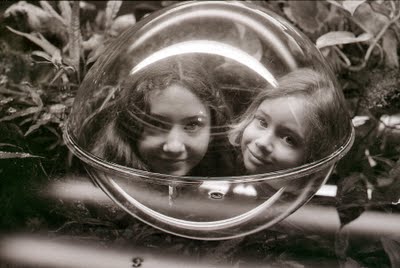 It was Brother Edwin who told us in our St. Ed’s High School theology class that even if Hitler were deemed to be a monster we still had to respect his humanity simply by the fact that he had been chosen by God to be born as a man. “There is an inherent human dignity in all of us,” Brother Edwin would often tell us. I have now modified that and extend it even to those garden pests. We are all in this together. It was with all the above contradictions that I gingerly entered the Vancouver Aquarium yesterday. Our guide was Rebecca who pretty well directed us from here to there with a luxury of relevant information on what we saw. She seemed to know a lot about the frogs. I had to remind her that one sight that would be absent was a South American (I believe that it was South American.) baby alligator that we had seen when she was 4 and 5. The alligator was a startling cream, yellow and brown. For close to a year when Rebecca would misbehave I would make or threaten to make phone calls to the señor crocodilo as Rebecca called the cocodrilo (Spanish for crocodile). Rebecca smiled and smiled again when she pointed to the entrance to the 4-D film. These are BBC 3-D Planet Earth documentaries in which you are gently misted with water (when whales splash) or feel vibrations under your seat when certain sea animals discharge electricity, etc. This was a thrilling experience. All in all, the aquarium seemed less a museum, less an aquatic zoo, and more an experience that caught the attention of even the most special-effects-blasé kid. This experience might even push a few of these children into more exploration; an exploration into the real thing, perhaps? It would seem to me that under the tutelage of John Nightingale, our Vancouver Aquarium is relevant in a most active way and I can only applaud the man who has stayed, through thick and thin, when others would have moved on.
Rhapsody In Blue
Saturday, February 06, 2010
Orpheum Vancouver Syphony Orchestra Conductor / Performers Bramwell Tovey conductor Larry Knopp Trumpet  Repertoire Gershwin Strike Up the BandGrofe Grand Canyon Suite: On the TrailScott Good Between the Rooms for Trumpet and Orchestra*Shelley Marwood In Pursuit (VSO Olympic Commission) Gershwin Rhapsody in BlueGershwin Porgy & Bess: SuiteWhile being told by my dental hygenist on Tuesday that I had a terrible cavity that would necessitate an expensive crown (“Off with the tooth,” I say) I heard a radio ad for a Vancouver Symphony Orchestra concert for today Saturday that features Gershwin’s Rhapsody in Blue. The concert is a popular one as when I attempted to find four tickets together yesterday I found none except some very cheap one up in the gallinero (chickencoop and as Argentines call the upper reaches of their venerable Teatro Colón) of the Orpheum. I bought the tickets. I will be attending the concert with my daughter Hilary and her two daughters Rebecca and Lauren. We will be sure to bring a couple of binoculars so we can watch Maestro Bramwell Tovey play the piano part of the Rhapsody in Blue. One would have to be sonically brain dead to not get thrills with the beginning of the Rhapsody in Blue with that vamping and swirling clarinet. The granddaughters had a sleepover with us last night. Rebecca, intelligently turned me down when I offered to play a recording of Gershwin’s singular concerto. After all I will be watching both girls as they experience that thrill that one can only experience once in one’s life which is to listen to a beautiful composition for the first time. I prepped up last night by listening to Miles Davis-Porgy and Bess with an orchestra directed by Gil Evans, anticipating tonight’s Porgy & Bess Suite. This led to Miles Davis’ Milestones and then to one of my faves, his Round About Midnight.My guess is that to the girls upstairs the music sounded like grandfather music. The will hear some more tonight. It is my hope that it will surprise them, delight them and make them more curious to see what else I may have in my living room music library.
A Belgian Eccentric & Toby The Cat
Friday, February 05, 2010
 I first met Doctor Peter Lekkas (above with Rebecca) about 10 years ago. We are both members of the Vancouver Rose Society. Lekkas has a delightful French accent and has been known to wear 19th century pith helmets. If you mention his accent as being French he will correct you, like that famous detective, “I am not French. I am Belgian.” Today I asked him, “Have you ever been to Waterloo?” His answer was immediate and with a smile on his face he said, “My brother lives nearby and we have played in Waterloo many times.” If Lekkas were British he would be considered an English eccentric. But since he is Belgian he is an excentric that drives a shiny red Citroën Deux Chevaux when he wants to drive. He bikes around town in most cases. I would never consider myself to be an eccentric as I am neither British nor Belgian but I must disclose that both Lekkas and I share a love and both own an unusual rose called Rosa ‘Ghislaine de Féligonde’. Rosemary and I have two cats. One, 19 years old, is the male cat Toby. Toby is Rosemary’s cat. My cat, Plata is 11 and a female. For some time I have known that the best cure for a dead cat is an instant new cat. Mosca, Rosemary’s black male cat died 6 years ago. At the time Rosemary was confined to her bed as she had had a brutal foot operation. I left Rosemary and Mosca in the morning. Both were watching Hitchcock’s Vertigo. When I returned some hours later the scene was the same. Mosca (right on the fridge) was at the foot of the bed asleep. Minutes later Rosemary screamed that Mosca was not moving and that he might be dead. I ran up and when I picked him up he was as stiff as a board. 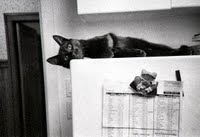 He had been dead for hours. Mosca’s replacement (after I broke my spade handle burying him in the garden) was a beautiful male tabby we called Niño. Within a month Niño died of cancer. Rosemary went to the SPCA in search of a male cat that would share our house with my female white, Polilla (moth in Spanish). We saw Toby and immediately fell for him. He was 14 years old so we decided not to. I returned a few months later and I spotted Plata a beautiful snow leopard like female. I noticed that Toby was still there. I brought Plata home. Plata and Polilla instantly began to fight. Polilla was defending her turf. Then one day I found Polilla outside, eviscerated by a raccoon. She was not a pretty sight. I buried her in the garden, and like clockwork I broke another spade handle. Rebecca and I returned to the SPCA. When Rebecca saw Toby she said, “Papi we have to bring Toby home because if we don’t he will be euthanized. We brought Toby home. It didn’t take Rosemary long to fall in love with Toby and for Plata (Plata is in front in picture below with Toby) and Toby to get along just fine. The situation was idyllic. 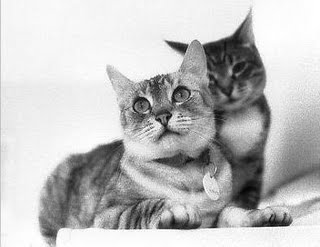 It all changed when Toby developed a thyroid problem. Doctor Margie from Cats Only prescribed some special pills we have forced into Toby’s mouth twice a day. Toby stabilized. Doctor Margie retired. We needed a new vet. Where was I going to find a new vet that I liked that was personal? To my delight I remembered that Lekkas was a veterinarian and that he had told me that he worked at the SPCA. We have been taking Toby to see him since. So we talk cats and roses and of Wellington and Napoleon. It has been pleasant. Then Toby began to lose weight. When Lekkas saw him, two weeks ago, he determined that not only was there a problem with the thyroid but also with the kidneys (a normal situation with a cat of Toby’s age). He told us to inject Toby with water every two days as he was dehydrated. He told us to feed Toby as often as he wanted to eat. Toby got worse. He pooped in our bedroom. He had always been a clean cat. He moved around as if he had feline dementia. Our daughter Hilary and granddaughter Rebecca said we should put him out of his misery. Hilary went as far as to tell her mother that she was selfish in wanting to keep the cat as he was. On Tuesday when Rosemary arrived from school she was surprised to find Toby at home. “I thought he would no longer be here.” I told her that you simply did not go to the SPCA and tell them to put down the cat. “You need to make an appointment first.” I called and made the date to see Peter Lekkas today. I didn’t think Rosemary would want to come, after all she thought that Toby’s trip to the vet might just be a one way trip. I explained to Rosemary that Lekkas would tell us what to do. “ He didn’t, but he did one better. He helped us make a good decision. Indeed the decision was a Wellingtonian close run thing. 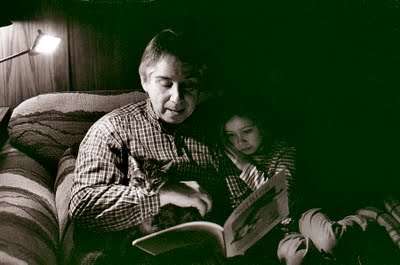 Lekkas looked at Toby and informed us he had lost a kilo in two weeks. But he also said, “Dr. Margie does not believe in euthanizing cats just like that. I don’t think Toby will be around in 6 months. You would be selfish if you wanted to get rid of a cat that is suddenly doing stuff on your carpets.” With that kind, reassuring smile of his (a Belgian smile, perhaps?) we left for home with Toby. We were both at peace. When we arrived Toby was spunky and ate and ate. I injected him with water and I watched how he licked himself clean, a sure sign that Toby’s demise may not be immediately forthcoming.
Our Olympic Baby, Calm Amidst A Storm
Thursday, February 04, 2010
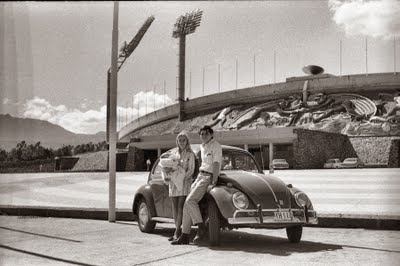
When our first daughter Alexandra Elizabeth was born August 27, 1968 we immediately dubbed her our Olympic baby. We were living in Mexico City at the time. The city and the nation were living with the anticipation and excitement of the Summer Olympics (officially called the Games of the XIX Olympiad) which were to open on October 12th, universally known in Latin America as “el Día de La Raza”. Latin Americans know that for better or for worse, Columbus Day marked the beginning of the mestizo race.
Mexico City was a city of unrest. The Mexican government and its president Gustavo Díaz Ordaz had invested a massive $150 million in preparations for the Olympics, (equal to roughly $7.5 billion dollars by today’s terms) a huge amount considering the poverty that was present then in Mexico. There were student protests all over the country. There were shouts of ¡No queremos olimpiadas, queremos revolución! ("We don't want Olympic Games, we want revolution!"). Finally in September, Ordaz ordered the occupation of the National Autonomous University by the army. In Mexico the often Hollywoodesque concept that a criminal can seek sanctuary in a church really applies to a university. The autonomous part of the name reflects a Mexican university’s traditional independence. They have always guarded this right/privilege. It is sacrosanct in Mexico. The rector of the university Javier Barros Sierra resigned in protest on September 23 when students were beaten and arrested indiscriminately.

The stage was set for what was called the Tlatelolco Massacre which happened on October 2. At the time there were a few radio stations in Mexico in English that had a direct radio feed from the CBS network in the US. I often listened to the station as I had affection for liberal radio columnist Nicholas Von Hoffman’s corrosive but funny comments (“If you really want to have a kid, adopt a baby goat.”) and Dan Rather's quiet spoken almost gentle Texas accent. CBS radio news was on at the top of every hour. That late afternoon broadcast began something like this, “There have been reports of army shootings at students at the Plaza of Three Cultures (Aztec, Spanish, Mestizo). We take you to our correspondent, live from Tlatelolco in Mexico City, ‘The army has been shooting at students who have gathered here. I see many dead…’
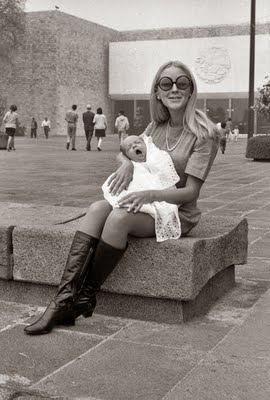 I could hear the gunshots and the shouts. Suddenly I heard a click and an announcer began, “The baseball scores for today are as follows: From the National League…” I switched the dial around and all I could hear was music. The Mexican government censors had taken care of all that after that small lapse in efficiency. It was quite a few years later that subsequent investigations on the massacre determined that snipers of the Presidential Guard had done much of the shooting and that at least 200 students had been killed.
Amidst all this I managed to drive our blue VW beetle to the University where the Estadio Olímpico was being readied for the opening ceremonies. As you can see from the picture here which I must have taken sometime in September, there was no indication of the army or of any activity. It seemed to be dead. But the army was there. I had been stopped by a soldier who told me I could not go any further. I remember teling him that we had an Olympic baby and we wanted to take a picture by the stadium. The soldier laughed and said, "Pase señor." And then he took the picture for us.
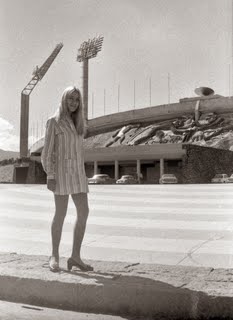
I often hear these days that living through an Olympics is a once-in-a-lifetime experience that one does not forget. I asked Rosemary this morning if she remembered anything. Her answer was a curt, “No.” I remember four events and two more.
I remember the wonderful highway of art that for miles featured beautiful and cutting edge sculpture from all over the world. These sculptures have survived to this day.
I remember going to a Greek play (appropriately performed by a Greek troupe in Greek). It might have been Aristophanes. I am not sure. But I do remember that the play was Greek to me and that every once in a while the actors would utter the word anthropos or nous. These were the only words I recognized.

I remember the Magic Lantern a phenomenal theatre production from former Czechoslovakia that mixed acting on stage with projections. The effects were similar to those old Laurel and Hardy films that had the two of them negotiating recklessly their car through intense traffic.
I remember watching (on TV) and being totally amazed by Bob Beamon’s (US) long jump of 8.90 metres (not broken until 1991).
But there were two events that will always live in my memory. One was the Mexican silver medalist Sargento José Pedraza in the 20km walk. While Mexico was able to win 9 medals in all (3 in each category of gold, silver and bronze) it was the win by this quiet and obviously mestizo soldier, ungainly, almost funny as he walked, who captured the hearts of Mexico. His silver medal soon became gold in my memory and only today was I able to correct it. The shy sergeant, left in picture, below) had won big between two Soviet Union behemoths.
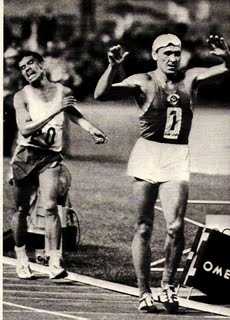
The other moment of note was to watch; American athletes Tommie Smith and John Carlos (first and third place) at the ceremony for the 200m sprint raise their fists in a “Black Panther” salute in protest to racism in America. The TV vision before my eyes was shockingly similar to another in my memory. It was that photograph of Jesse Owens in triumph in the 1938 Berlin Summer Olympics, while the German athlete, a member of the then "superior" race raised his arm in a salute to Hitler and the Japanese athlete quietly minded his own business.
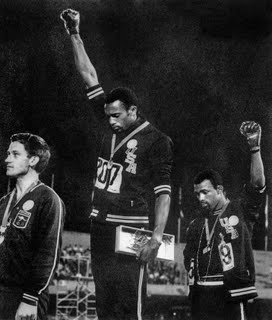
Perhaps at my age and situation I have a good excuse for feeling about the Olympics the way Scrooge felt about Christmas. I might have warmed up a bit to a Summer Olympics but the winter sports leave me literally and figuratively cold. If I had the resources I would be packing for a visit to Mérida in Mexico or Trelew in Patagonia.
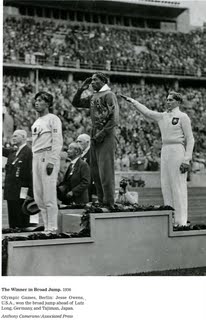
But who knows I just might catch that Olympic spirit yet and those words, ¡No queremos olimpiadas, queremos revolución! will fade away.
As I look at these pictures I get fond memories (My! are Rosemary's legs beautiful!) of what seemed to be the simpler times of my youth. As soon as Ale (Alexandra) had been born, my mother had come to visit us at our little apartment on Calle Estrasburgo in the Zona Rosa. "What you need is an English pram,” She told us. She picked up the English language newspaper The News and said, "Here is one. Let me call." The used English pram was made of finely lacquered (dark blue) wood). Soon after, we paraded our daughter on the elegant Paseo de la Reforma. Behind Rosemary and the pram you can see the bulk of the American Embassy. It was about then that Americans began to prepare for a worldwide siege on their embassies. Sargento Pedraza's win marked, in my opinion, a shift in Mexico. The Mexican soccer teams playing in games abroad where now called los Aztecas or el equipo cobre (the copper coloured team). Sargeant Pedraza's win in what was considered then a laughable sport became a symbol of the true amateur winning in a field of highly paid "amateur" athletes. Sargeant Pedraza's win may have marked the first awareness of the Mexican mestizos that they were indeed equal to any other race. They became proud and la Raza movement exploded into the US.
Indeed, good things can come out of the Olympics.
The conquest of Mexico
Columbus' egg
The Swimmer - Not
Wednesday, February 03, 2010
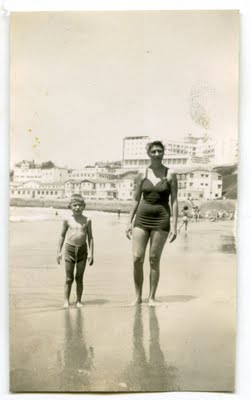 He took off a sweater that was hung over his shoulders and dove in. He had an inexplicable contempt for men who did not hurl themselves into pools. He swam a choppy crawl, breathing either with every stroke or every fourth stroke and counting somewhere well in the back of his mind the one-two one-two of a flutter kick. It was not a serviceable stroke for long distances but the domestication of swimming had saddled the sport with some customs and in his part of the world a crawl was customary. To be embraced and sustained by the light green water was less a pleasure, it seemed, than the resumption of natural condition, and he would have liked to swim without trunks, but this was not possible considering his project. He hoisted himself up on the far curb – he never used the ladder – and started across the lawn. When Lucinda asked where he was going, he said he was going to swim home.
The Swimmer, John Cheever
He took off a sweater that was hung over his shoulders and dove in. He had an inexplicable contempt for men who did not hurl themselves into pools. He swam a choppy crawl, breathing either with every stroke or every fourth stroke and counting somewhere well in the back of his mind the one-two one-two of a flutter kick. It was not a serviceable stroke for long distances but the domestication of swimming had saddled the sport with some customs and in his part of the world a crawl was customary. To be embraced and sustained by the light green water was less a pleasure, it seemed, than the resumption of natural condition, and he would have liked to swim without trunks, but this was not possible considering his project. He hoisted himself up on the far curb – he never used the ladder – and started across the lawn. When Lucinda asked where he was going, he said he was going to swim home.
The Swimmer, John Cheever
As I was writing the blog yesterday about my lifelong infatuation with Charlotte Rampling I kept thinking of The Swimming Pool, a 2003 film directed by François Ozon, a spooky but sensual film, equal parts Eric Rohmer and Alfred Hitchcock. That film, in English made me remember another fine Ozon film, in French (also with Charlotte Rampling ) called Under the Sand (2000) which also had some haunting water scenes.
Visions of Rampling poolside competing quite well at her age with the much younger French star Ludivine Sagnier persisted. From The Swimming Pool my thoughts instantly drove me to take out from one of my living room bookshelves, John Cheever’s, The Stories of John Cheever. I went for the index and found that story I had read back in 1979, The Swimmer. It is one of my favourite short stories even though I have never really liked short stories. I prefer the longer journey of character development of the novel. I read my share of short stories and particularly science fiction short story compilations in the 50s and in the 60s.
To this day The Swimmer holds up as did the 1968 film version of the story (which I saw years after I read the story). The film was directed by Frank Perry and Sydney Pollack and it features the beautifully athletic body (in swimming trunks for the duration of the film) of Burt Lancaster. The film is depressing as you watch Lancaster become older and older as he transverses the swimming pools of his suburban Connecticut town. There is a beauty, a sensuality, in his performance that I recognized in Rampling’s presence in The Swimming Pool.
I have no idea if Rampling can swim. For sure, Lancaster can and does so in The Swimmer. In some way Lancaster and Rampling combine to project images of my mother, who was the consummate swimmer. Her crawl was flawless and her back stroke never produced even the tiniest of ripples as she swam from one side of a pool to another.
I never saw or remember my father swimming. Yet when I asked his former wife (he had been married before he met my mother) if my father danced the tango I was met by a look of surprise. My mother had often told me how well George danced the tango and how when they danced in the cabarets of Paseo Colón people would stop to stare at them. It seemed so, his former wife said, that George was a beautiful swimmer. “He taught me to swim. We often went swimming.” The swimmer danced the tango and the tango dancer swam, But his women never did catch on that he did both.
Not only did I inherit my mother’s beautiful legs I also inherited her beautiful feet. "Some day you are going to be a fine swimmer," she would tell me. And for years she asserted that I would inherit my father’s talent for tango. For many years both of my mother’s predictions became lead weights in my mind. I was much too shy to dance in my high school years and suffered for it by not having girl friends. Swimming parties were always an embarrassment because my efficient breast stroke could not hide my pitiful crawl. In 1975 I tried to address my swimming flaws and took stroke improvement classes at the YMCA. My swimming improved just a bit but the breakthrough was that I photographed a French Canadian woman who placed my pictures in the frames of the gift department of Holt Renfrew where she worked. That led to portrait jobs with the wealthy Vancouver Cohen family and an eventual job at Vancouver Magazine via fashion editor Gabriel Levy.
Perhaps some 12 years ago I decided to learn the Argentine tango. I took lessons. I became an efficient dancer, no more and no less.
I have made efforts to swim and tango back into my past to no avail. I can only remember the noise of the waves in Mar del Plata when my grandmother must have taken the snap you see here of my mother with the little boy who would one day grow not to be a swimmer or a tango dancer.
Tis Pity She's A .....
Tuesday, February 02, 2010
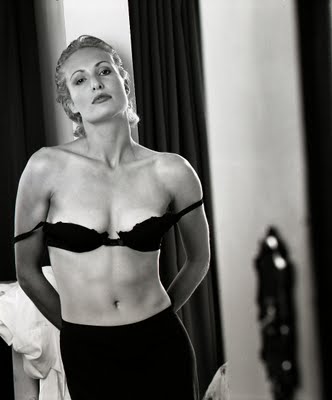
Dirk Bogarde 'The Look'
I remember being surprised, and showing it rather obviously, when Luchino Visconti, reading through the cast of a film which I had just agreed to make with him, said’…and finally I will use the English girl Charlotte Rampling for the young wife who is sent to the concentration camp…’
‘Rampling! But why?’ I remember saying tactlessly. Visconti placed the forefinger and thumb of each hand around his eyes, framing them. ‘For this,’he said. ‘For the Look.’
…Rampling keeps her own sensuality well banked down, but one is constantly aware of the fire below in the lithe walk, the measured tread, the slender length of leg, the curve of the neck and throat and perhaps, most of all, in the meaning and the suggestions which lie behind the Look. Those alone can still a breath. It seems all that is necessary.
Dirk Bogarde, Paris 23.2.87

In 1973 I took my Mexico City private high school 10th graders to the movies. My wife Rosemary accompanied us. The film was called Tis Pity She’s a Whore. It was directed by Giuseppe Patroni Griffi and the female lead (most important) was the dazzling Charlotte Rampling (picture, right, by photographer Angelo Frontoni). I thought I was safe in taking my students to see this “art” film since the screenplay was based on a play by the English Jacobean/Caroline playwright John Ford (1586-1640). The Italian film had the same title as Ford's play.
My students were a good bunch and kept their mouths shut in school the next day. I was given no trouble by the principal who was a member of the John Birch Society. I went home with the visions of Charlotte Rampling wearing nothing on an elaborate bed inside a Venetian palazzo.
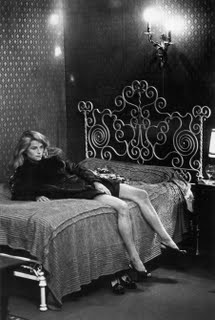
In 1987 I made one of my usual trips to Toronto to see magazine art directors. I would show them my portfolio and attempt to get new work. This ploy sometimes worked. What was memorable of that trip is that I went to a huge bookstore, off Yonge Street, and found a book, Charlotte Rampling – With Compliments. It is an autobiographical picture book (from the very beginning and up to 1987) and it has an introduction by Dirk Bogarde. I will not go here into why anybody who reads this should immediately find a DVD version of The Night Porter (with Bogarde and Rampling) or if not in such a daring spirit go for: Luchino Visconti’s tamer The Damned.
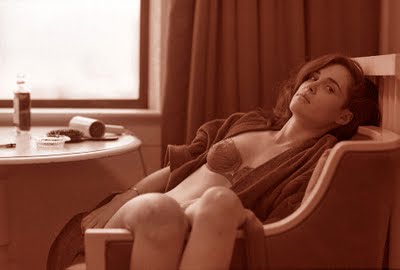
While I would place Grace Kelly, Audrey Hepburn, Deborah Kerr or Jean Simmons on a pedestal and admire each one chastely, I might consider leaving Rosemary to cook her own meals while I was off for a weekend with Charlotte Rampling (with or without my camera).

It was in the Rampling book that I saw four photographs of her by Helmut Newton including the one you see here taken in an expensive Paris hotel room. There was Venice and there was Paris. Here I was in Vancouver. What could I possibly do after all that inspiration? The adapted formula became a steady stream of women that faced my camera in the best room that Tony Ricci could muster in his Marble Arch Hotel. I photographed very beautiful women.
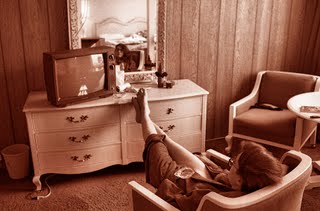
I photographed unusually endowed women. I photographed handsome women. Those who frequent this blog have seen quite a few of them. But it has been in the last month that I figured it all out. I will never find a Charlotte Rampling. I have had many failures which are not the fault of the women who posed for me.
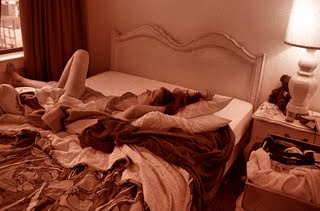
It was a failure of approach. In the beginning I was much too inexperienced and all I wanted was to photograph my subjects without clothing. These pcitures lack the class of Helmut Newton. In the end, the secret to my modest success was the use of clothing to hide and of undergarments that were simple.

This combination produced pictures, particularly those of Claire Love (who did go to Paris) that you see here and are all tinted in red. The other photograph is one of my early attempts. The picture is fine, the woman, Vantana, is beautiful but there is something missing. I take the blame.
 
   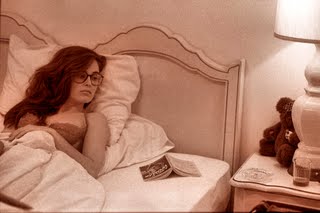 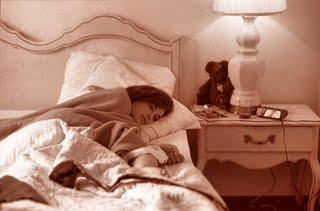 
 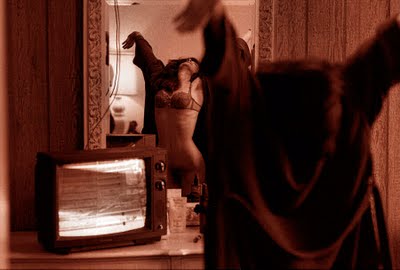
Visceral & Cerebral
Monday, February 01, 2010
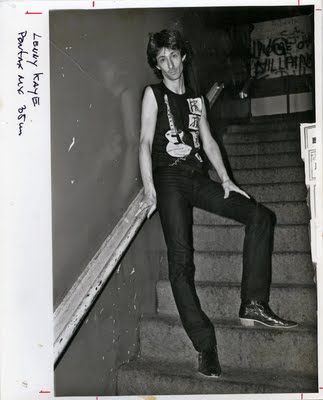
Les Wiseman, Rear Window, The Vancouver Sun, April 20, 2000
This pic was shot early morn, late 1981 on the stairway that led from the stage to the dressing rooms in the legendary Gary Taylor’s Rock Room on Wasserman’s Beat (Hornby between Georgia and Dunsmuir). It was the last night for that venue. Taylor’s was always a great place, featuring an eclectic variety of rock bands from mainstream, to blues to punk. In the main room, the rock crowd could sit in upholstered banquettes and swill with an approximation of nightclub sophistication. Downstairs, at various times, there were strippers and karaoke. Upstairs, in the dressing rooms there was rock’n’roll abandon.
In 1981, Taylor’s had become a mini Manhattan where any given week you could catch Johnny Thunders and the Cosa Nostra, Jane County and the Electric Chairs or the Lenny Kaye Connection.
Kaye had risen to fame first by being one of the gods of rock criticism with Rolling Stone, Creem and Rock Scene, and compiling the essential 1960s garage band album, Nuggets. Thereafter he became friends with punk visionary Patti Smith, while he was working at a record store called Village Oldies in New York. Smith persuaded him to dance in the aisles to The Bristol Stomp by the Dovelles.
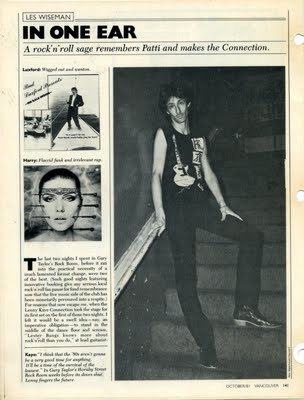 By 1971 he was playing guitar while Smith recited her poetry to 150 people at Saint Mark’s Church. This was the Patti Smith Group birthed. The resultant single, Hey Joe/Piss Factory, produced by Kaye, was the seminal punk recording that led to Horses, the 1975 Smith LP that ushered in the age of punk rock as much as did the rise of The Damned, Ramones, Television and The Sex Pistols. The Smith Group released four albums and had a hit with Bruce Springsteen’s Because the Night. Then Patti Smith retired to married life with husband Fred “Sonic” Smith, Formerly of MC5.
With her husband’s death in 1994, Smith worked through her grief with new albums always featuring the stalwart Kay on lead guitar The Patti Smith Group appears at the Commodore Ballroom on Saturday [April 22, 2000].
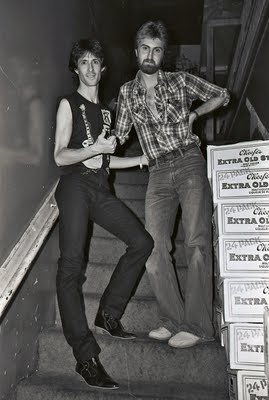 After the original demise of the group, Kaye formed The Connection and released an album. I Got a Right was picked up by the cognoscenti, but was not commercially boffo. After his Vancouver appearance with The Connection I wrote and article on Kay for my Vancouver Magazine In One Ear column. He had left me his address, so I sent the piece off to him and a couple of weeks later received a letter thanking me for writing about him and if I was ever in NYC to look him up. In March of 1983, I called Country Rhythms magazine (Kaye was a contributing editor) from a hotel off Times Square and told them that I was looking for Kaye. Within a half-hour, Kaye called and invited photographer Alex Waterhouse-Hayward and me to the Danceteria for a poetry reading by Jim Carroll that night.
It can hardly be overestimated how cool it was to walk up to the door of the hippest club in Manhattan and tell the doorman, “We’re on Lenny Kaye’s guest list.” Inside we spotted Kaye’s gaunt frame. We introduced ourselves and he introduced us to the two guys he was talking with: Jim Carroll, below left, the author of The Basketball Diaries and leader of The Jim Carroll Band, and David Johansen former lead singer of The New York Dolls, later to become Buster Poindexter. It was rock fan-writer paradise.
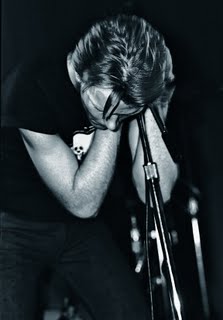 Now Smith and Kaye are back, making music both visceral and cerebral with the new album, Gung Ho. Kaye in 1981 said that the Smith Group was a purely ‘70’s phenomenon.
“It’s like we did it,” he explained. “And I think Patti, above all people, realizes that once you did it, why bother doing it again? We set out to be a totally idealistic art project, and we maintained it throughout our whole life. And to me, Patti calling a halt to it only vindicates her art.”
Kaye’s statement still stands valid. But time and loss change everything.
Les Wiseman, 2000
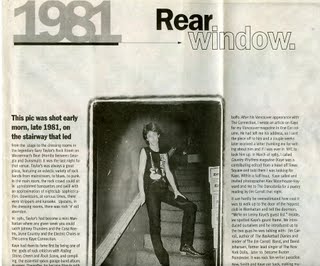
On Sunday I talked with Les Wiseman and former CBC and Sony Records honcho rep Dave Chesney to see what I could possibly tell my students at VanArts on Monday in a class called Editorial Rock Band Photography. I lay on the floor a long stream of 11x14 prints of many of the rock performers I photographed for Les Wisman's Vancouver Magazine column In One Ear. Few if any of the pictures registered any kind of recognition in my class. Few if any were interested in knowing who the people were. I pointed out the NY Times Literary Magazine review of Patti Smith's autobiographical account of her life with photographer Robert Mapplethorpe, Just Kids. Only a couple in class knew who either Patti Smith is or Robert Mapplethorpe was. I would have been wasting my time to recommend the wonders of listening to a recording of Johnny Thunders playing Louie Louie to no avail. I felt a bit sad and disconnected. And then I thought and realized that it was in 1979 that I first experienced Vancouver's Art Bergmann his dazzling and passionate guitar at the Smiling Budhha. I was 37 years old. My students have plenty of time to discover the joy of listening to a fast and furious electric guitar by that master of the whammy bar, Lenny Kaye.
And I remember the words of Les Wiseman, "Our magazine was a give away yet it was a fine magazine. To this day people tell me how they appreciated In One Ear." Or as Lenny Kaye said in Wiseman's piece above, "It's like we did it." I think that should be enough for both of us.
|












































